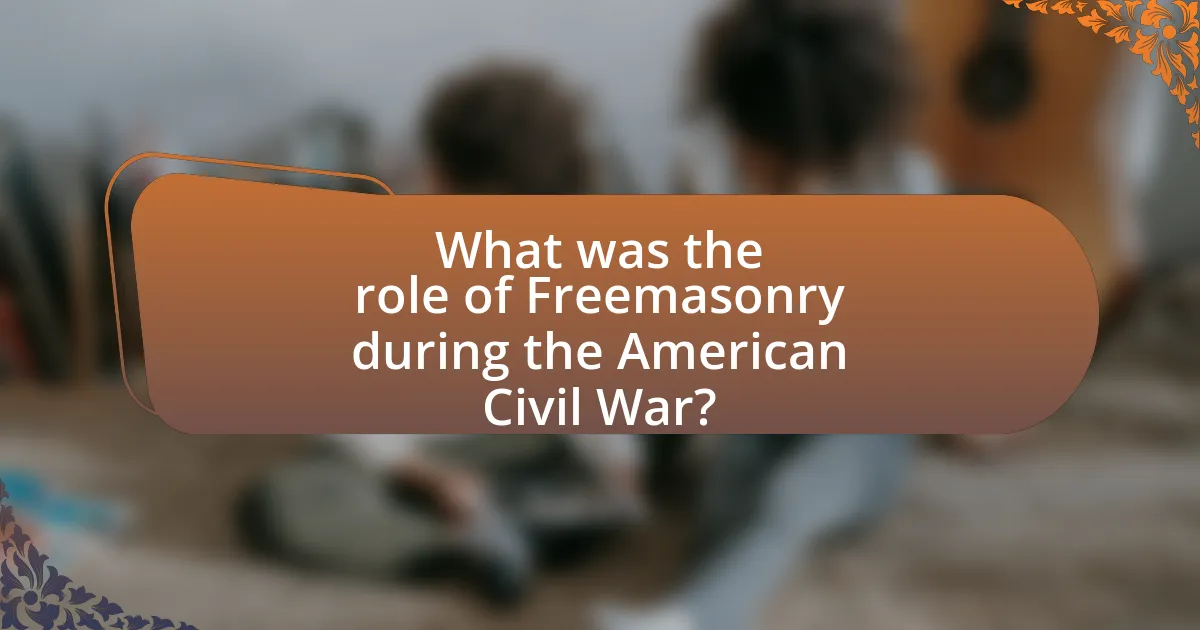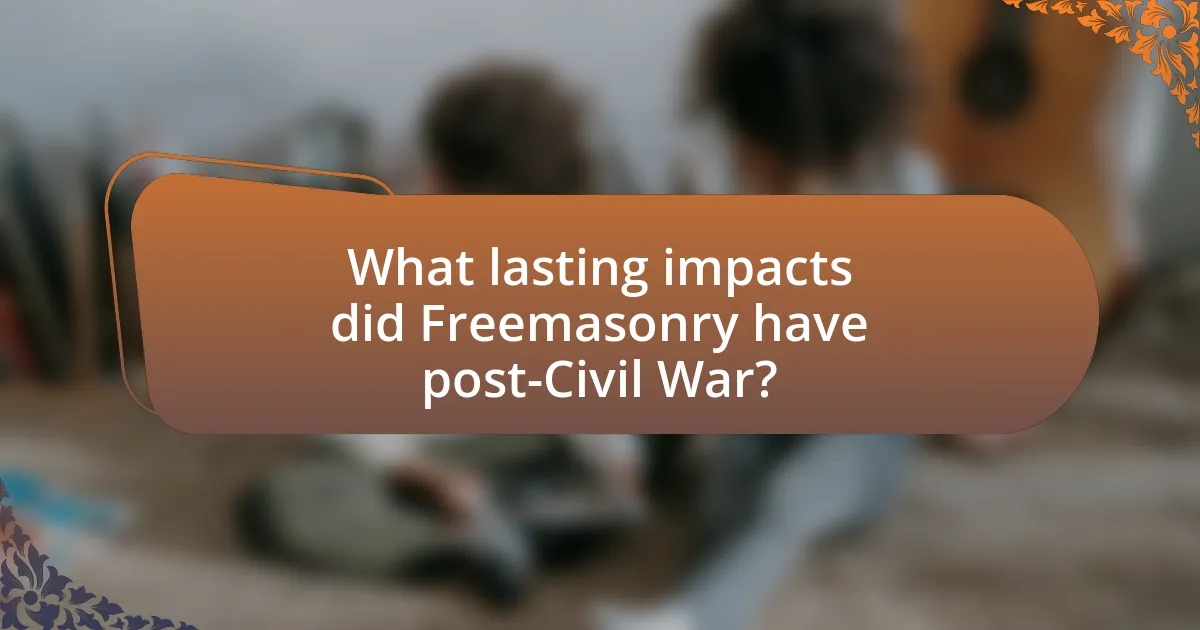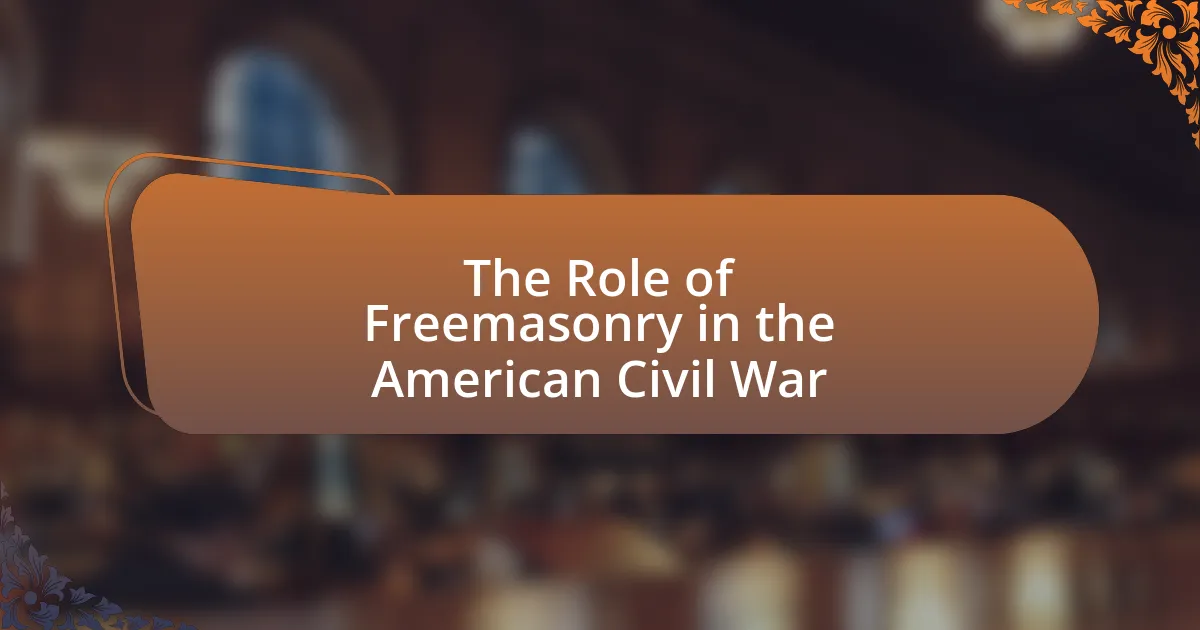Freemasonry played a pivotal role during the American Civil War by fostering brotherhood and mutual support among its members, who often found themselves on opposing sides. Prominent figures such as Union General William Tecumseh Sherman and Confederate General Albert Pike were Freemasons, facilitating communication and camaraderie despite the conflict. Masonic lodges provided essential aid to soldiers and their families, promoting ideals of unity and reconciliation that were crucial in the post-war period. The article explores the influence of Freemasonry on the political landscape, military leadership, and community cohesion during the war, as well as its responses to issues of slavery and secession, highlighting the organization’s lasting impacts in the aftermath of the conflict.

What was the role of Freemasonry during the American Civil War?
Freemasonry played a significant role during the American Civil War by fostering a sense of brotherhood and mutual support among its members, who were often on opposing sides of the conflict. Many prominent military and political leaders, including Union General William Tecumseh Sherman and Confederate General Albert Pike, were Freemasons, which facilitated communication and camaraderie despite the war’s divisions. Additionally, Masonic lodges provided aid to soldiers and their families, offering financial support and resources, which helped to alleviate some of the hardships caused by the war. The organization also promoted ideals of unity and reconciliation, which were crucial in the post-war period as the nation sought to heal from its divisions.
How did Freemasonry influence the political landscape of the Civil War?
Freemasonry significantly influenced the political landscape of the Civil War by fostering connections among key political figures and promoting ideals of democracy and brotherhood. Many prominent leaders, including President Abraham Lincoln and Confederate General Albert Pike, were Freemasons, which facilitated communication and collaboration across political lines. The Masonic principles of equality and fraternity resonated with the abolitionist movement, impacting public sentiment and political discourse. Additionally, Masonic lodges served as venues for political meetings and discussions, further intertwining Masonic influence with the political strategies of both the Union and the Confederacy.
What key Masonic figures emerged during the Civil War period?
Key Masonic figures that emerged during the Civil War period include Albert Pike and Andrew Johnson. Albert Pike was a prominent Confederate Mason who served as a general and was influential in the Southern jurisdiction of Freemasonry, contributing to the development of the Scottish Rite. Andrew Johnson, who became President after Lincoln’s assassination, was also a Mason and played a significant role in the post-war reconstruction efforts. Their Masonic affiliations influenced their leadership and decisions during this tumultuous time in American history.
How did Masonic principles shape the ideologies of leaders on both sides?
Masonic principles significantly influenced the ideologies of leaders on both the Union and Confederate sides during the American Civil War by promoting values such as brotherhood, equality, and liberty. These principles fostered a sense of unity and moral obligation among members, which leaders like Albert Pike for the Confederacy and William Howard Taft for the Union embraced to justify their respective causes. Pike, a prominent Confederate leader, utilized Masonic ideals to advocate for Southern nationalism, while Union leaders often invoked the Masonic commitment to democracy and equality to rally support for the war effort. The shared Masonic heritage among many leaders created a framework for dialogue and mutual respect, even amidst conflict, illustrating how these principles shaped their political and social ideologies during the war.
What social functions did Freemasonry serve during the Civil War?
Freemasonry served several social functions during the Civil War, primarily providing a sense of community, support, and moral guidance to its members. The organization facilitated mutual aid among soldiers and their families, offering financial assistance, care for the wounded, and burial services. Historical records indicate that Masonic lodges often acted as social hubs, fostering camaraderie and brotherhood among men from different backgrounds, which was crucial during the divisive period of the war. Additionally, Freemasonry promoted values such as charity and integrity, which helped maintain morale and a sense of purpose among its members amidst the chaos of conflict.
How did Masonic lodges support soldiers and their families?
Masonic lodges supported soldiers and their families during the American Civil War by providing financial assistance, care packages, and emotional support. Many lodges organized fundraising efforts to help families of deployed soldiers, ensuring they had the necessary resources for daily living. Additionally, Masonic lodges sent care packages containing food, clothing, and medical supplies to soldiers on the front lines, demonstrating their commitment to the well-being of both active service members and their families. Historical records indicate that Masonic organizations played a crucial role in establishing relief funds and support networks, which were vital during the war, highlighting their significant contribution to the welfare of those affected by the conflict.
What role did Freemasonry play in community cohesion during wartime?
Freemasonry played a significant role in fostering community cohesion during wartime by providing a structured support network for its members and their families. This organization facilitated mutual aid, emotional support, and a sense of belonging among individuals facing the challenges of conflict. Historical records indicate that Masonic lodges often organized relief efforts, such as providing food, shelter, and financial assistance to soldiers and their families, which helped maintain social stability during the upheaval of the American Civil War. For instance, many lodges contributed to the establishment of hospitals and care facilities for wounded soldiers, reinforcing community ties and solidarity in a time of division.
What were the Masonic responses to the issues of slavery and secession?
Masonic responses to the issues of slavery and secession were varied and complex, reflecting the diverse views within the organization. Many Masons opposed slavery on moral grounds, advocating for abolition and promoting the idea of equality among all men, which aligned with Masonic principles of brotherhood. For instance, prominent Masonic figures such as Albert Pike expressed anti-slavery sentiments, while others in the South defended the institution as a social and economic necessity.
Regarding secession, some Masonic lodges in the South supported the Confederacy, viewing it as a legitimate response to perceived federal overreach, while Northern Masons largely opposed secession, advocating for the preservation of the Union. The Grand Lodge of Pennsylvania, for example, issued resolutions condemning secession and urging loyalty to the Union.
These responses illustrate the internal divisions within Freemasonry during the Civil War, as the organization grappled with the moral and political implications of slavery and the conflict between states’ rights and national unity.
How did Freemasonry’s values conflict with the institution of slavery?
Freemasonry’s values fundamentally conflict with the institution of slavery due to its core principles of equality, liberty, and brotherhood. Freemasonry promotes the idea that all individuals are equal regardless of race or social status, which directly opposes the hierarchical and oppressive nature of slavery. Historical documents, such as the Masonic Constitution of 1723, emphasize the importance of treating all men with respect and dignity, reinforcing the belief that slavery is incompatible with Masonic teachings. Additionally, many prominent Freemasons, including figures like Albert Pike, publicly denounced slavery, advocating for the rights and freedoms of all individuals, further illustrating the inherent conflict between Masonic values and the institution of slavery.
What actions did Masonic organizations take regarding secessionist sentiments?
Masonic organizations actively opposed secessionist sentiments during the American Civil War. They promoted unity and loyalty to the Union, emphasizing the importance of national integrity over regional divisions. Masonic leaders and lodges often held meetings to discuss the implications of secession and encouraged members to support the federal government. For instance, many Masons participated in fundraising efforts for Union troops and organized rallies to bolster morale against the Confederacy. This collective action demonstrated their commitment to preserving the nation and countering the divisive rhetoric of secessionist factions.
How did Freemasonry’s influence manifest in military leadership?
Freemasonry’s influence in military leadership during the American Civil War manifested through the shared values and networks among Masonic members, which facilitated camaraderie and strategic alliances. Prominent military leaders, such as Generals Ulysses S. Grant and William Tecumseh Sherman, were Freemasons, and their connections often led to mutual support and trust in command structures. The Masonic principles of brotherhood and loyalty fostered a sense of unity among officers, which was crucial in the context of the war. Additionally, Masonic lodges served as informal meeting places for military leaders to discuss strategies and coordinate efforts, enhancing operational effectiveness. Historical records indicate that many soldiers and officers identified as Freemasons, contributing to a culture of solidarity that influenced decision-making and morale on the battlefield.
Which prominent military leaders were Freemasons during the Civil War?
Prominent military leaders who were Freemasons during the Civil War include Albert Pike, who served as a Confederate general and was a significant figure in Freemasonry, and William Tecumseh Sherman, a Union general known for his “March to the Sea.” Albert Pike was a 33rd-degree Mason and authored several Masonic texts, while Sherman was initiated into Freemasonry in 1860. Their involvement in Freemasonry is well-documented, highlighting the organization’s influence among military leaders during this period.
What impact did their Masonic affiliations have on their leadership styles?
Masonic affiliations significantly influenced the leadership styles of key figures during the American Civil War by fostering values such as brotherhood, mutual support, and ethical conduct. These principles often translated into collaborative decision-making and a focus on unity among leaders, which was crucial in a time of national division. For instance, many prominent leaders, including General Albert Pike and President Andrew Johnson, utilized their Masonic connections to build alliances and promote camaraderie among troops and political allies, enhancing their effectiveness in leadership roles. The emphasis on moral integrity and civic responsibility inherent in Masonic teachings also encouraged leaders to adopt a more principled approach to governance and military strategy, impacting their decisions and actions throughout the conflict.
How did Masonic networks facilitate communication among military leaders?
Masonic networks facilitated communication among military leaders by providing a structured and secretive framework for interaction. These networks allowed leaders to share information, coordinate strategies, and build alliances through established rituals and symbols that transcended regional and political divides. For instance, during the American Civil War, prominent figures such as General Albert Pike and General William Tecumseh Sherman utilized their Masonic connections to exchange critical intelligence and foster collaboration among troops. This interconnectedness was crucial in a time of fragmented communication channels, enabling military leaders to maintain operational coherence and mutual support despite the chaos of war.
What role did Freemasonry play in the morale of troops?
Freemasonry significantly boosted the morale of troops during the American Civil War by fostering a sense of brotherhood and mutual support among soldiers. This fraternal organization provided emotional and psychological reinforcement, as members shared common values and beliefs that transcended the battlefield. Historical records indicate that Masonic lodges often served as meeting places for soldiers, where they could find camaraderie and encouragement, which was crucial in maintaining their spirits during the hardships of war. Additionally, Masonic rituals and symbols offered a sense of continuity and hope, helping troops cope with the stress and uncertainty of combat.
How did Masonic rituals and symbols provide comfort to soldiers?
Masonic rituals and symbols provided comfort to soldiers by fostering a sense of brotherhood and shared values among them. These rituals created a supportive community that emphasized moral integrity, mutual aid, and the importance of loyalty, which were crucial during the hardships of war. For instance, Masonic symbols such as the square and compass served as reminders of ethical conduct and personal responsibility, helping soldiers maintain their morale and sense of purpose amidst the chaos of battle. Historical accounts indicate that many soldiers found solace in Masonic gatherings, where they could connect with fellow members, share their experiences, and reinforce their commitment to the principles of Freemasonry, thus alleviating feelings of isolation and fear during the American Civil War.
What initiatives were taken by Masonic lodges to boost troop morale?
Masonic lodges initiated various programs to boost troop morale during the American Civil War, including the provision of care packages, financial support, and the establishment of communication networks. These lodges organized the collection and distribution of essential supplies such as food, clothing, and medical aid to soldiers in the field, which directly addressed their needs and improved their spirits. Additionally, Masonic lodges often held events and gatherings to foster camaraderie among troops, reinforcing their sense of brotherhood and support. Historical records indicate that these initiatives were crucial in maintaining morale, as they provided soldiers with tangible reminders of home and community support during challenging times.

What lasting impacts did Freemasonry have post-Civil War?
Freemasonry had significant lasting impacts post-Civil War, particularly in promoting social cohesion and rebuilding efforts in a fractured nation. The organization provided a framework for mutual support and community rebuilding, as many members were involved in charitable activities that addressed the needs of war veterans and their families. Additionally, Freemasonry fostered a sense of brotherhood that transcended regional divides, aiding in the reconciliation process between the North and South. Historical records indicate that Masonic lodges became centers for dialogue and cooperation, contributing to the broader societal healing during Reconstruction.
How did the Civil War reshape Freemasonry in America?
The Civil War significantly reshaped Freemasonry in America by leading to a fragmentation of lodges along regional lines and altering membership dynamics. The conflict caused many Masons to align with either the Union or the Confederacy, resulting in the establishment of separate Masonic jurisdictions that reflected the political divisions of the time. For instance, after the war, the Grand Lodge of the Confederacy was formed, which operated independently from the Grand Lodge of the United States, illustrating the deep impact of the war on Masonic unity. Additionally, the war prompted a reevaluation of Masonic values, emphasizing brotherhood and charity, as many lodges engaged in relief efforts for soldiers and their families, thereby reinforcing the organization’s social role in a time of crisis.
What changes occurred in Masonic membership and structure after the war?
After the war, Masonic membership and structure experienced significant changes, including a decline in membership and a shift towards more localized lodges. The war had disrupted many lodges, leading to a loss of members who either did not return or were affected by the societal changes post-war. Additionally, the structure became more decentralized as lodges focused on community service and rebuilding local ties, reflecting the broader societal need for support and unity in the aftermath of the conflict. This shift was evident in the increased emphasis on charitable activities and local governance within the Masonic community, adapting to the new social landscape of post-war America.
How did the war influence the public perception of Freemasonry?
The war significantly altered public perception of Freemasonry by associating it with patriotism and national unity. During the American Civil War, many Freemasons served in the military, which led to the perception that the organization was supportive of the Union cause. This involvement fostered a sense of camaraderie and loyalty among members, enhancing the image of Freemasonry as a force for good in society. Additionally, prominent figures in the war who were Freemasons, such as General Albert Pike, contributed to the organization’s visibility and respectability. Consequently, the war helped solidify Freemasonry’s reputation as a benevolent institution committed to the welfare of the nation.
What lessons can be learned from Freemasonry’s involvement in the Civil War?
Freemasonry’s involvement in the Civil War teaches lessons about unity, brotherhood, and the impact of shared values in times of conflict. During the Civil War, many Freemasons fought on both sides, demonstrating that despite political and ideological differences, the principles of fraternity and mutual support transcended divisions. Historical records indicate that Masonic lodges provided aid to soldiers and their families, fostering a sense of community and support regardless of allegiance. This involvement highlights the importance of solidarity and the potential for organizations to promote peace and understanding even amidst civil strife.
How can contemporary organizations draw from Masonic principles during conflict?
Contemporary organizations can draw from Masonic principles during conflict by emphasizing values such as brotherhood, mutual respect, and ethical conduct. These principles encourage open dialogue and collaboration, which can help resolve disputes amicably. For instance, Masonic teachings advocate for the importance of understanding differing perspectives, fostering an environment where all parties feel heard and valued. Historical examples, such as the role of Freemasons in promoting unity during the American Civil War, illustrate how these principles can facilitate reconciliation and cooperation even in times of deep division. By applying these Masonic values, organizations can create a framework for conflict resolution that prioritizes harmony and constructive engagement.
What best practices can be adopted from Freemasonry’s historical role in community support?
Freemasonry’s historical role in community support demonstrates several best practices that can be adopted today, including fostering mutual aid, promoting civic engagement, and encouraging charitable giving. Freemasons established relief funds and organized community services during the American Civil War, providing essential support to soldiers and their families, which exemplifies the importance of structured assistance in times of crisis. Additionally, Freemasonry’s emphasis on brotherhood and unity can inspire modern organizations to build strong networks that facilitate collaboration and resource sharing, enhancing community resilience. The documented efforts of Freemasons in providing medical care, food, and shelter during the war highlight the effectiveness of organized community support systems in addressing urgent needs.
